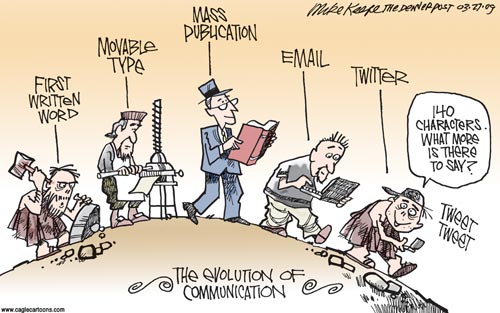Twitters tweeting: What's the point?
Posted in The Gnovis Blog
Two scrambled eggs, coffee, orange juice…delicious. 7:52 a.m.
banana…all mushed up. i hate eating like a toddler. 12:24 p.m.
chocolate milkshake and A TUNA MELT! makin’ serious progress. 4:47 p.m.
Today, if I had tweeted the most moaned-about topic, the above would have been shared with the world. No one ever cared what I ate until a few weeks ago. During a flag-football game, I fractured my jaw and for the first time since childhood, people have become oddly interested in what I’ve been ingesting for every meal.

Since I don’t have many followers on Twitter and follow only a few more, I chose not to share my adjusted diet this way. What value would it add to my story? To the story of CCT, Georgetown, the DC area, the world? Who would care? But ever since I’ve been directly asked the most joked-about tweet topic, I’ve been thinking a lot about Twitter.
About a week ago, Chief Twitter scientist, Abdur Chowdhury, stopped by Georgetown to present a talk to the Computer Science department, “Discovery and Emergence,” which focused on the questions: What possibilities emerge from surfacing the world’s conversations to others? How can the awareness of the thoughts of others cause the emergence of new behaviors?
He rhetorically posed the question, “What’s it like working somewhere that simultaneously matters, and then completely doesn’t?” This seemed to encapsulate the whole reason I’ve only participated as a follower on Twitter and never actually tweeted, and why many of the students in attendance asked why Twitter mattered at all.
I’ve found that a lot of people within two years of my age (22 to 26 year-olds) do not use Twitter on a regular basis. This past week in our introductory CCT course, students were asked how often they tweeted and responded with an astounding majority of “never”. During group discussion in the same class, students joked that they had never ‘twitted’ and did not see the point. At an event at the House of Sweden called Native Digital Tourists, a sample of ‘digital experts’ of high school students and CCT students led their elders on a tour around the digital landscape. Only a small fraction raised their hand to admit to tweeting. But someone out there is using the service, as Twitter boasts 175 million users.
Twitter changed its “What are you doing?” prompt to “What’s happening?” in 2009 and now portrays itself as a global, real-time news service by all citizens. Twitter aggregates all the tiny, individual stories, and once a story ‘trends’ in a metropolitan area, it becomes a news item.
In Dr. Chowdhury’s Twitter discussion, one student asked about the point behind Twitter, stating that it was something small that has not quite become mainstream. His rather snarky reply, “Yeah, 175 million users is pretty insignificant,” made the student loseWeight Exercise the courage to pursue the issue. Others continued to point out the white elephant of Twitter: sharing breakfast menus with similar questions. Then he presented a visualization of all the tweets during the 2009 Superbowl: Steelers versus Cardinals.
Watch the NY Times Visualization
In less than a minute, this visualization provides a rather nuanced version of the country-wide discussion on Twitter and what they thought was important. Individually, these tweets would mean nothing, but taken as a slice of a particular dynamic on a specific day, they can tell a story.
Similar to the storytelling power of Twitter during the Superbowl, Dr. Chowdhury also presented a visualization of the Haitian earthquake earlier this year and tweets that occurred Thanksgiving day 2008, the day of the Mumbai bombings. You can literally watch citizens around the globe responding to the news of the day. Enough people use Twitter to tell these major news stories, and probably more nuanced ones as well.
During the Digital Tourists event, CCT Professor Michael Nelson mentioned that the power of his own Twitter network lay in the fact that he selected each Tweeter to add value for him to his stream of updates – to strengthen his networked knowledge in his areas of interest. Following vignettes of acquaintances adds value to my social experience because I can keep up with friends’ activities in real time.
I don’t use Twitter often enough to says it’s a news-gathering source; however, I use Facebook a lot, probably more than a lot. Several times a day I scan the status updates from my selected network of friends. I cannot answer why or even what I’m looking for, but it did tell me the surprise snow dusting in Western North Carolina, a new breakthrough artist on WXPN, midterm election results, and other activities of my 600-plus “friends.”
Toward the end of the discussion, many computer science students were still yearning for a reason behind the tweeting, scratching their heads for the answer to “Why Twitter?”
Dr. Chowdhury failed to provide a concrete answer, and I don’t think it’s his or even Twitter’s place to decide why their service and technology is important. It really seemed as if the computer science students were really asking, ‘How can Twitter be a viable company with real profits?” Repeatedly, the moral of his lecture was ‘change the world,’ and he chose a few charity trends to demonstrate Twitter’s possible impact. At this point, changing the world seems a bit grandiose.
Creating a dialogue between diverse cultures and witnessing a topic that unites us is definitely a good start.
